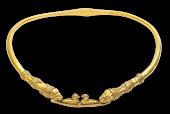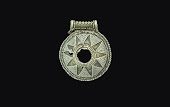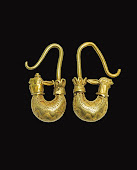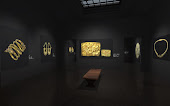 The National Museum of History of Moldova, in partnership with the Arbor Institute for Culture, invites you to discover or rediscover the exhibition "ANCIENT JEWELRY. The Treasures of the National Museum of History of Moldova", the new virtual exhibition hosted on Theopen-art.com, the first platform for art exhibitions in virtual reality in the Republic of Moldova and Romania.
The National Museum of History of Moldova, in partnership with the Arbor Institute for Culture, invites you to discover or rediscover the exhibition "ANCIENT JEWELRY. The Treasures of the National Museum of History of Moldova", the new virtual exhibition hosted on Theopen-art.com, the first platform for art exhibitions in virtual reality in the Republic of Moldova and Romania.
The 24 pieces of jewelry presented in this virtual exhibition belong to the period between the 5th millennium BC and the 17th century AD, although all come from archaeological research of the sites between the Prut and the Dniester, their origin is associated with the communities which lived between the Balkans and the Carpathians and up to the Caucasus and had trade relations with the population of the Northern Black Sea region. The objects selected for this exhibition are rare, exceptional artifacts, made by our predecessors in metal and precious stones; they are of great cultural, historical and artistic value.
These impressive museum pieces, which can be admired in real at the permanent exhibition "Treasures of the Past" of the National Museum of History of Moldova, were found by Moldavian archaeologists during the period from the 1960s to 2015, if we refer to the latest find that is part of this collection presented in virtual reality. Although some of the discoveries were made by teams, we still want to mention a few names of archaeologists who brought to light and researched these valuable adornments: G. Fedorov, G. Chebotarenko, T. Shcherbakova, N. Chetraru, V. Vornic, V. Bubulici, and S. Popovici.
Made of gold or silver, adorned with precious stones or without, jewelry has always symbolized the wealth, influence, and sometimes magical power of its owners.
The National Museum of History of Moldova (NMHM) is one of the most important museum institutions in the Republic of Moldova, both in terms of its collections and its scientific prestige. Founded in 1983, the museum keeps 348,619 heritage items, a varied typology of which reflects the history of Moldova over the centuries, from prehistoric eras to the present, showing the human habitat, facts, events, outstanding personalities. Since its establishment until now, NMHM has organized over 650 temporary exhibitions in the country and abroad, focusing on its own collections, as well as on cooperation with other cultural and research institutions.
In recent years, the archaeological heritage of the Republic of Moldova has been highlighted in important international exhibitions organized in partnership with European and overseas museums, such as the exhibition "Cucuteni-Trypillia, Una Grande Civilta dell 'Antica Europa" at the Vatican, the exhibition "The Lost World of Old Europe. The Danube Valley, 5000-3500 BC" held in New York (USA), Oxford (UK), and Athens (Greece), "KRIEG - Eine Archaeologishe Spurensuche" in Halle (Germany), and "Visigoths. Rois de Toulouse" in Toulouse (France). In Romania, the NMHM heritage was part of important thematic exhibitions held in Bucharest, Iași, Suceava, Brăila, Vaslui, and Alba Iulia.
The Arbor Institute for Culture is a subsidiary of the Arbor Association for Culture and Arts in Romania, founded by cultural manager Victoria Nagy Vajda, whose mission is to promote the high artistic values of the Republic of Moldova and to support cultural mobility within the Romanian cultural space and abroad. The activity program of the association provides for the implementation of joint cultural projects with state cultural institutions, in addition to the extensive activities that it carries out in partnership with the independent artistic field. "ANCIENT JEWELRY. The Treasures of the National Museum of History of Moldova" is the second exhibition realized by the Arbor in partnership with a museum from the Republic of Moldova. The first VR exhibition, "Tribute to the Romanian Language: Bessarabian writers in the work of artist Valentina Rusu Ciobanu" was organized in partnership with the Mihail Kogălniceanu National Museum of Literature in the Republic of Moldova, under the curatorship of Maria Șleahtițchi and Victoria Nagy Vajda.
The VR gallery on the Theopen-art.com platform has an area of 300 square meters, distributed in 5 exhibition areas, where large or smaller exhibitions of painting, sculpture, photography, and multimedia can be held. The creation of the Theopen-art.com platform was supported by the Swiss Cooperation Office in the Republic of Moldova and by the non-governmental organizations Arbor Institute for Culture (Republic of Moldova) and the Arbor Association for Culture and Arts (Romania) through Victoria Nagy Vajda.
Virtual exhibitions can only be visited on a desktop or laptop computer with an updated web browser. VR exhibitions are not available from mobile phones.
Instructions: Use the arrow keys and the mouse/trackpad to navigate in the VR exhibition. To exit, press the ESC key twice.
Organizers: National Museum of History of Moldova, Arbor Institute for Culture
Curators: Mariana Vasilache, deputy director; Victoria Nagy Vajda, cultural manager
Photographers: Iurie Foca, Mihail Băț, Denis Topal
The photographs are taken from the catalog "Piese de giuvaiergerie antică din colecțiile Muzeului Național de Istorie a Moldovei" ("Pieces of ancient jewelry from the collections of the National Museum of History of Moldova") by Ana Niculiță, 2018; editors: Eugen Sava, Aurel Zanoci.
Link: https://www.theopen-art.com
VR: Augmented Space Agency - virtual frontier explorers, architects of augmented spaces and designers of new digitally mediated experiences.























































